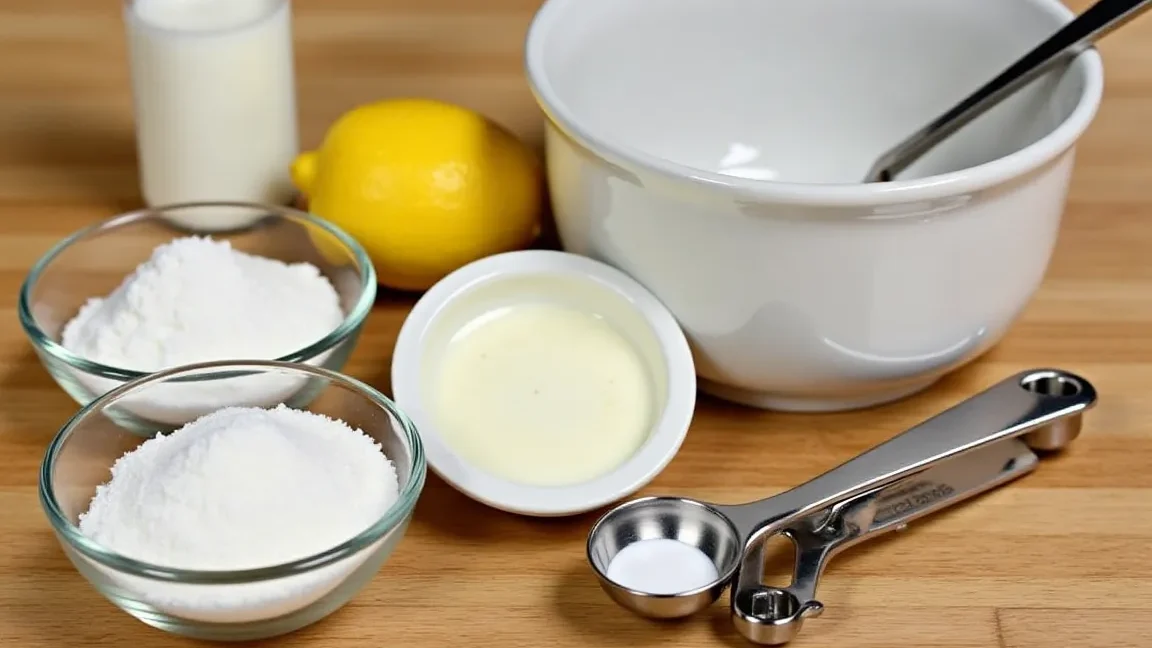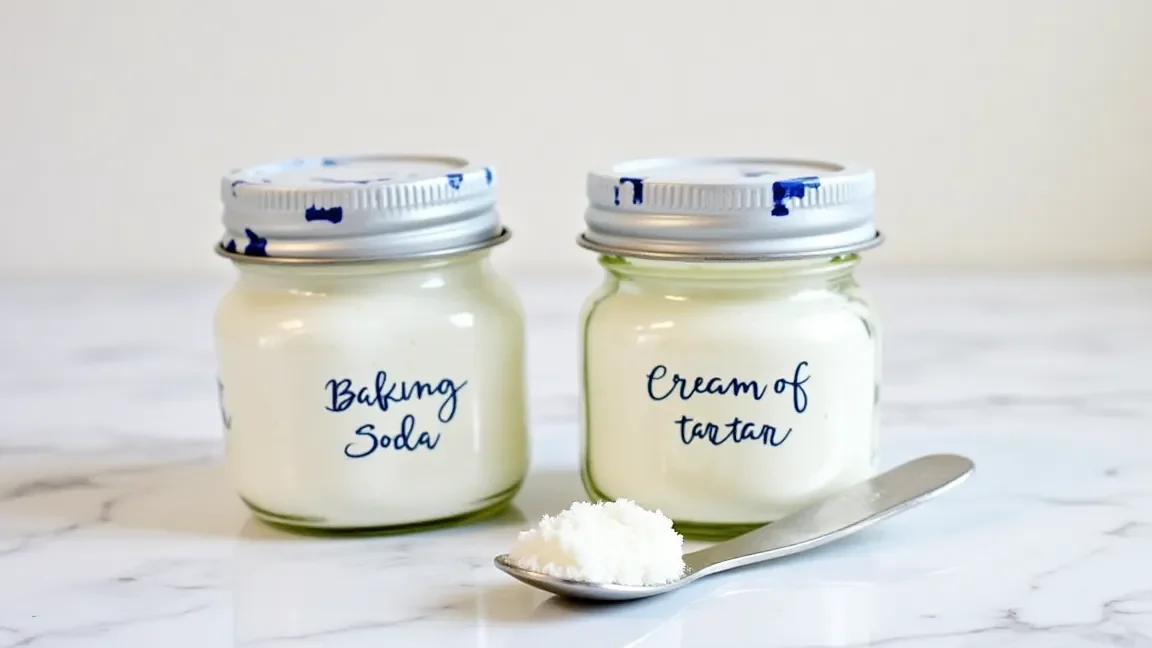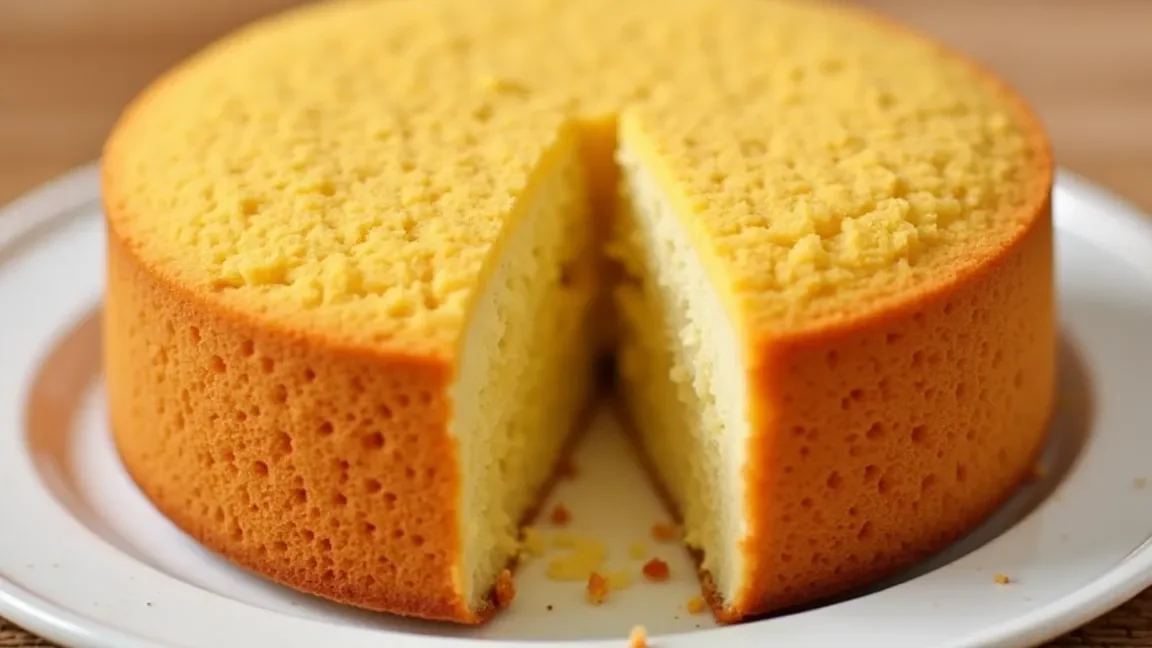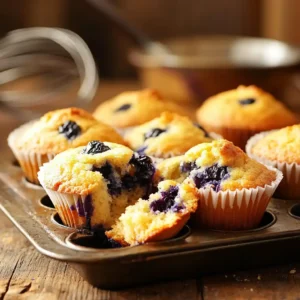This guide explains baking powder substitutes. We’ll cover what Replacement for baking powder does and why you might need a replacement, and we’ll offer alternatives with instructions.
Table of Contents
Understanding Baking Powder
What is Baking Powder?
Baking powder helps baked goods rise. It’s a combination made of baking soda, and acid. This combination creates tiny bubbles of gas when it gets wet, making cakes and cookies fluffy.
Types of Baking Powder
Single Acting Baking Powder
Baking powder with a single action releases of its gas when it becomes wet. It is essential to bake your items using this baking powder immediately.
Double Acting Baking Powder
Double acting baking flour releases gas when it’s wet, and another when it’s heated in the oven. This means that you can mix your batter prior to time. Most baking powder you buy at the store is double acting.

Why You Might Need a Substitute
Sometimes, you need a baking powder substitute. This happens for two main reasons:
Running Out of Baking Powder
You might run out of baking powder! This is a common baking problem. Having a substitute on hand helps you finish your recipe.
Allergies
Some people have allergies to ingredients in baking powder. A substitute lets them enjoy baked goods safely. If you have an allergy, always check the ingredients of any substitute to be sure it is safe for you.
Baking Soda and Acid: The Classic Replacement
Using Baking Soda and an Acid
Baking soda alone won’t make your baked goods rise. It needs an acid to react. Common acids include lemon juice and vinegar. This mixture results in similar gas bubbles to those created by baking powder.
Recipe Amounts
Here’s how much to use for a typical recipe that calls for one teaspoon of baking powder:
IngredientsQuantityNote
Baking soda 1/2 teaspoon the equivalent of half the baking powder amount.
Acid (Lemon Juice or Vinegar) 1/2 teaspoon Use either lemon juice or vinegar; they work equally well.
Important Considerations
Be sure that you mix baking soda with acid prior to adding the other wet ingredients. This ensures the reaction happens properly. The acid type you select could alter the flavor of the baked goods you bake. Experiment to see what you prefer!

Alternative Leavening Agents
Yeast for Bread
Yeast is a single celled organism. It makes carbon dioxide gas, which makes bread rise. It is common to use yeast for bread baking, but not cakes or cookies. Yeast needs warmth and time to work.
Self Rising Flour
Self rising flour already contains baking powder, and salt. This makes baking easier. You can use self rising flour when a recipe calls for all purpose flour, but remember to adjust other ingredients (like salt) as needed. Check the recipe instructions. Recipes using self rising flour often need less baking powder.
Recipes and Examples
Muffin Recipe with Baking Soda and Vinegar
This recipe shows how to replace baking powder in muffins. It makes use of baking soda as well as vinegar to act as the leavening agents.
Ingredients:
- 1 1/2 cups all purpose flour
- 1/2 cup sugar
- 1 teaspoon baking soda
- 1/2 teaspoon salt
- 1/2 teaspoon vinegar
- 1 cup milk
- 1 egg
- 1/4 cup melted butter
- 1/2 cup blueberries (or your favorite mix ins)
- Instructions:
- Preheat your oven to 400°F (200°C). Line a muffin tin using the liners of paper.
- Within a bowl mix together sugar, flour baking soda, flour, and salt.
- In a separate bowl, combine vinegar and milk. Let it sit for a minute to fizz.
- Incorporate the wet ingredients in the dry ones, as well as the egg and butter that has been melted. Stir gently until just combined. Don’t overmix.
- Fold in the blueberries (or your favorite mix ins).
- Fill the muffin cups about 2/3 full.
- Bake in the oven for about 18-20 minutes, or until a knife inserted in the center is clear.
Cake Recipe with Self Rising Flour
This recipe shows how to make a cake using self rising flour instead of baking powder. Selfrising flour already has baking powder as well as salt.
Ingredients:
- 2 cups self rising flour
- 1 cup sugar
- 1/2 cup (1 stick) unsalted butter, softened
- 2 large eggs
- 1 cup milk
- 1 teaspoon vanilla extract
- Instructions:
- Preheat your oven to 350°F (175°C). Grease and dust a 9×13 inch baking pan.
- Within a bowl mix the sugar and butter until it becomes light and fluffy.
- Beat the eggs, one at a Then, stir into the vanilla.
- Gradually add the self rising flour and milk to the wet ingredients, alternating between the two, beginning and ending with the flour. Mix until just combined.
- Pour the batter into the cake pan. Bake for 30 to 35 minutes or until a wooden skewer that has been inserted into the middle is clean.
- Remember always to check your recipe carefully and adjust ingredients accordingly when substituting. Enjoy baking!
Troubleshooting Baking Powder Substitutions
Flat Baked Goods
If your cakes or muffins are flat, the baking powder substitute may not have worked correctly. Make sure you mix the baking soda and acid (like lemon juice or vinegar) well before adding other wet ingredients. The reaction needs to start before you combine everything. Not enough acid will also cause flat baked goods.
Off Flavors
Using baking soda and an acid can slightly change the taste. Lemon juice has a citrusy flavor, while vinegar has a tangy taste. Experiment to find what you like best! If the taste is too strong, try reducing the amount of acid next time.
Uneven Rising
Sometimes, only parts of your baked goods rise. This might mean the baking powder substitute wasn’t evenly distributed in the batter. Make sure to mix your batter thoroughly, but don’t overmix. Overmixing can also lead to tough baked goods.
Using Self Rising Flour
Remember, self rising flour already has baking powder and salt. If you use it, check your recipe carefully. You may need to adjust the amount of salt or other ingredients. A lot of baking powder could make baked goods taste bitter.
Other Issues
If you are still having problems, make sure your oven is at the correct temperature. An oven that’s too cool or too hot will also affect how your baked goods rise. Always check your recipe and follow the instructions closely. Baking is a science, and getting consistent results takes practice.

Storing Baking Powder and Substitutes
Keeping Baking Powder Fresh
Store baking powder in a cool, dry place. A cupboard away from heat and moisture is best. Make sure the container is tightly sealed to keep air from getting inside. This helps it stay fresh and powerful. Check the expiration date; baking powder loses its strength over time.
Storing Baking Soda
Baking soda, a common baking powder substitute, also needs a cool, dry place. Like baking powder, a tightly sealed container keeps it fresh. Baking soda can last longer that baking powder..
Storing Acidic Substitutes
If you’re using lemon juice or vinegar as part of a baking powder substitute, store them as you normally would. Lemon juice in a sealed container in the refrigerator stays fresh for a while. Vinegar is shelf stable.
Using Self Rising Flour
Self rising flour already contains baking powder. Follow storage instructions for baking powder for self rising flour as well. Remember, self rising flour often needs less baking powder in a recipe.
Troubleshooting Baking Powder Substitutions
Fixing Flat Baked Goods
If your cakes or muffins are flat, the substitute might not have worked. Make sure you mix the baking soda and acid (like lemon juice or vinegar) well before adding other wet ingredients. The reaction needs to start before combining everything. Not enough acid also causes flat baked goods.
Dealing with Off Flavors
Using baking soda and an acid can change the taste a little. Lemon juice adds a citrusy flavor, while vinegar is more tangy. Experiment to find what you like! If the taste is too strong, use less acid next time.
Uneven Rising Problems
If only parts of your baked goods rise, the substitute might not be evenly mixed. Mix the batter well, but don’t overmix. Overmixing makes baked goods tough.
Using Self Rising Flour Correctly
Self rising flour has baking powder and salt. Check your recipe; you may need less salt or other ingredients. Too much baking powder makes baked goods bitter.
Other Baking Issues
If you still have problems, check your oven temperature. An oven that’s too cool or too hot affects how baked goods rise. Always follow the recipe carefully. Baking takes practice.
For more insights on substitutions, check out Can I Use Cornstarch Instead of Baking Powder?.
Frequently Asked Questions
What if my baking powder substitute doesn’t work?
If your baked goods are flat, the substitute may not have reacted properly. Ensure you mix the baking soda and acid (like lemon juice or vinegar) thoroughly before adding other wet ingredients. Insufficient acid can also cause this.
Why do my baked goods taste strange?
Using baking soda and an acid can slightly alter the taste. Lemon juice adds a citrusy note, while vinegar gives a tangier flavor. Experiment to find your preference! If the taste is too strong, reduce the amount of acid next time.
Why did only parts of my cake rise?
An uneven rise suggests the substitute wasn’t distributed evenly. Mix the batter well, but avoid overmixing, which can make baked goods tough.
Can I use self rising flour in any recipe?
Self rising flour contains baking powder and salt. Always check your recipe; you might need to adjust the amount of salt or other ingredients. Baking powder too much can produce a bitter taste.
What if my oven temperature is wrong?
Incorrect oven temperature affects how baked goods rise. Ensure your oven is at the correct temperature, as stated in your recipe.
How long does baking powder last?
Store baking powder in a cool, dry place in a tightly sealed container. Make sure you check the expiration date. baking powder will lose its effectiveness with time.
How do I store baking soda and acidic substitutes?
Baking soda should also be stored in a cool, dry place in a sealed container. Lemon juice should be refrigerated in a sealed container, while vinegar is shelf stable. Self rising flour should be stored like baking powder.
Conclusion: Baking Powder Replacement Success
Using This Guide
This guide showed you ways to replace baking powder. You learned about different kinds of baking powder and why you might need a substitute. We covered using baking soda with an acid like lemon juice or vinegar and using self rising flour. Remember to follow the instructions carefully for each substitute.
Successful Baking
Making good baked goods takes practice. Experiment with different substitutes to find what you like best. Pay attention to how your baked goods rise and taste. This helps you become a better baker!
Next Steps
Now that you know how to replace baking powder try baking something new! Use the recipes in this guide as starting points. Remember always to check your recipe and adjust ingredients as needed. This guide will help you replace baking powder. Follow the instructions carefully.

Muffin Recipe with Baking Soda and Vinegar
Equipment
- Oven
- Muffin tin
- Paper liners
- Large bowl
- Whisk
- Separate bowl
- Toothpick
Ingredients
- 1 1/2 cups all-purpose flour
- 1/2 cup sugar
- 1 teaspoon baking soda
- 1/2 teaspoon salt
- 1/2 teaspoon vinegar
- 1 cup milk
- 1 egg
- 1/4 cup melted butter
- 1/2 cup blueberries (or your favorite mix-ins)
Instructions
- Preheat your oven to 400°F (200°C). Line a muffin tin with paper liners.
- In a large bowl, whisk together flour, sugar, baking soda, and salt.
- In a separate bowl, combine vinegar and milk. Let it sit for a minute to fizz.
- Add the wet ingredients to the dry ingredients, along with the egg and melted butter. Stir gently until just combined. Don’t overmix.
- Fold in the blueberries (or your favorite mix-ins).
- Fill the muffin cups about 2/3 full.
- Bake for 18-20 minutes, or until a toothpick inserted into the center comes out clean.
